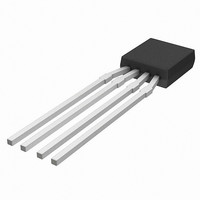KMZ10C,112 NXP Semiconductors, KMZ10C,112 Datasheet - Page 20

KMZ10C,112
Manufacturer Part Number
KMZ10C,112
Description
IC MAGNETIC FIELD SENSOR SOT195
Manufacturer
NXP Semiconductors
Type
Special Purposer
Specifications of KMZ10C,112
Sensing Range
2mV/V
Voltage - Supply
5 V ~ 10 V
Output Type
Analog
Operating Temperature
-40°C ~ 150°C
Package / Case
SOT-195
Mounting Style
SMD/SMT
Maximum Operating Temperature
+ 150 C
Minimum Operating Temperature
- 40 C
Supply Voltage (min)
5 V
Supply Voltage (max)
10 V
Operating Temperature (min)
-40C
Operating Supply Voltage (typ)
5V
Lead Free Status / RoHS Status
Lead free / RoHS Compliant
Current - Supply
-
Current - Output (max)
-
Features
-
Lead Free Status / Rohs Status
Lead free / RoHS Compliant
Other names
933698480112
KMZ10C T/R
KMZ10C T/R
KMZ10C T/R
KMZ10C T/R
Philips Semiconductors
The optimal method of compensating for temperature
dependent sensitivity differences in MR measurements of
weak fields uses electro-magnetic feedback. As can be
seen from the sensor characteristics in Figs 21 and 22,
sensor output is completely independent of temperature
changes at the point where no external field is applied
(the null-point). By using an electro-magnetic feedback
set-up, it is possible to ensure the sensor is always
operated at this point.
To achieve this, a second compensation coil is wrapped
around the sensor perpendicular to the flipping coil, so that
the magnetic field produced by this coil is in the same
plane as the field being measured.
Should the measured magnetic field vary, the sensor’s
output voltage will change, but the change will be different
at different ambient temperatures. This voltage change is
converted into a current by an integral controller and
supplied to the compensation coil, which then itself
produces a magnetic field proportional to the output
voltage change caused by the change in measured field.
1998 Jun 12
handbook, full pagewidth
Magnetic field sensors
Fig.23 Magnetic field directions and the flipping and compensation coils.
earth's field
flipping field
compensation coil
20
The magnetic field produced by the compensation coil is in
the opposite direction to the measured field, so when it is
added to the measured field, it compensates exactly for
the change in the output signal, regardless of its actual,
temperature-dependent value. This principle is called
current compensation and because the sensor is always
used at its ‘zero’ point, compensation current is
independent of the actual sensitivity of the sensor or
sensitivity drift with temperature.
Information on the measured magnetic signal is effectively
given by the current fed to the compensating coil. If the
field factor of the compensation coil is known, this
simplifies calculation of the compensating field from the
compensating current and therefore the calculation of the
measured magnetic field. If this field factor is not precisely
known, then the resistor performing the current/voltage
conversion must be trimmed. Figure 24 shows a block
diagram of a compensated sensor set-up including the
flipping circuit.
compensation field
sensor KMZ10A1
flipping coil
MLC757
General














